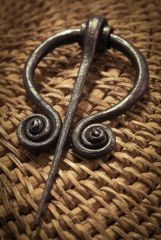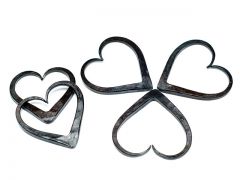-
Posts
171 -
Joined
-
Last visited
Content Type
Profiles
Forums
Articles
Gallery
Downloads
Events
Everything posted by Tubbe
-
Hi, In this tread I want to show the tools I have made, hugely inspired by the tools Brian Brazeal makes. I've tried to suck up as much information as possible from all posts Brian has made and all the images that Lyle Wynn has posted. I'm really just a beginner, but with all that info, some thought and trial and error, it's actually possible to do some pretty ok stuff. First thing I made was an eye drift with a punch grind on the end, then I made the hammer tongs to be able to hold hammers/top tools with an eye in a secure way. Then today I made my first handled tool, the eye punch. Both drift and punch were made out of 1" car axle stock, and neither one has been heat treated. Punching the hole. This is actually the hardest part when you work alone. I used a half round bottom swage to help me hold the piece. Then it's just a matter of getting the hole straight and in line.... :) Hole drifted and cheeks forged out using the drift as an anvil, from both sides. Has to be worked quite fast as these thin parts cool real fast, even with a drift up in temp. Striking end fixed up. I'm a little curious how thin you actually can make the cheeks, after all it's made to be hit by a sledge hammer.... Round taper Finished. Flattened taper and V shaped punch end. Simple handle My plan is to add some other tools to this thread in the future. Hope all this can be some sort of inspiration for you all....
-
Made myself a pair of these tongs yesterday. This is the result. The reins came out a bit short perhaps. The total length is 16". Lets see if they're any good... :) Planning to do some handled top tools to start with.
-
-
-
-

Hearts for Valentine's Day
Tubbe replied to brianbrazealblacksmith's topic in Blacksmithing, General Discussion
Hi, I just had to try these as well. Good exercise for both brain and body -
Done! I'm pretty happy with the result. Yes clinton, I also encountered the problem with the tip splitting when forging the thin part of the taper. I rewelded the tip, and decided not to go any thinner. I may have forged the tip at too low temp. I read everywhere that when forging a welded part you should forge at almost welding temperature. I don't know if that's always true, though... I don't know if I would recommend doing your first "forge welded bundle" at this size... the bundle with collar measured 1 5/8" (pre weld). With that mass one need allot of heat and you should let it soak for a good while to get even temperature for all of the bundle. Don't rush and get half good weld as I did :)
-
Well... the weld is done, but not 100% successful. The collar partially split open during the tapering and I realized the upper part was probably not completely welded.Don't know if it's possible to fix at this stage... however, it wont fall apart as it is. My plan was to punch and drift a hole in the tapered welded part, but I'm starting to feel thats a bad move...
-
Hi, I started a new project this week, a chandelier, inspired by Brian Brazeals method of joining pieces together in a forge welded bundle. Lets see how that goes... Started off with pieces of 5/8" square, which I tapered down leaving a 1" chunk on the end for the actual candle holder. Next up - welding the bundle! One thing that worries me is how I'm going to form/bend the arms into shape after the weld is done... could be a problem to reach into the fire with my side draft hood. Time will tell :)
-
Hi again. Small and final update - First fire!!
-
Thanks freeman. I have used a slot punch, which makes 10x3mm holes. I then drift to 10mm round for the rivets.
-
Thanks for all kind words. Wire weeled and painted today! Added the hammer for reference. I thought I'd share the initial design. Since I work with 3d computer graphics professionally I tend to play around with ideas. This is what I came up with then. Pretty close to the end result. Here is the tool. Nothing fancy, just two pieces of steel connected with a bit of spring-steel and a suitable hole drilled deep enough to make the rivet stock extend 1,5 diameter above for the head.
-
Well, I thought that too for a while, but actually in this case the slot should be the same length as the diameter of the finished hole, i think. As you drift the material outwards only, the length should stay the same, in theory... but in reality for the holes I made here I got lengthening by ~0.8mm for each hole. Not much, but can be an issue in some cases.
-
Well, it's hard to say...quite a few sessions, but in total I would say around 20-30h including the rivet making tool. It's definitely something I will keep as it was never intended for someone else. Price, hmmm, expensive it is... only the material is around $100. On a market it would probably be around $1000-$1500. But seriously, if one is to make these for sale you need to tool up for the power hammer and make jigs for bending and stuff... now, every piece is hand bent without any guides, only to a simple drawing as reference. Thanks Brian! Yes I have used your punch design, and it works very well. I punch in one heat and drift the hole in a second heat. I use 3 drifts after one another with planishing in between. I touched up the tip of the punch once with a file, but it's holding up surprisingly well although the thin tip looses harness almost immediately. I try to cool it after each or every second blow but it heats up really fast. The key is to not get stuck, and to be determined in what you are doing. One thing I was worried about was swelling or lengthening of the material and how that would affect all measurements, but actually it was really only an issue with the two upper rings. Since the upper ring only has 8 holes compared to 16 on the middle. But I made the middle ring first and compensated for the 1.4 cm lengthening I got from the 16 holes. I wonder if it's possible to punch and drift holes with greater accuracy, I mean with no length wise swelling? Hmm, I have some additional pictures to show, but I am unable to upload... weird. I get "This upload failed" or "Upload Skipped (Error500)"... what is going on? And thanks again for all warming comments!
-
Hi, Thanks for the comments. I should have photographed with some reference... anyhow.. It is 85cm high and the top diameter is 40cm, and I can add that it's quite heavy. Round rivets, yes! One thing left, and that is to coat it with some fire-proof paint I guess.
-
Hi there, I completed my first "larger" project last week, a fire basket of my own design. To make the joinery more pleasing I decided from the beginning that I would punch and drift all holes. In total there are 45 rivets and thus 90 holes made. Hmm... quite a lesson in punching and drifting. Each hole was made in two heats. To fit everything I bolted the hole thing first, then removed one bolt at a time and riveted. I even had to make a simple tool to manufacture the 45 rivets. I used 5x30mm flat bar for the basket and 10mm round for the rivets. Sadly, I don't have more than this picture of the making of... The rings completed Some of the plugs from punching the slots for the holes. Finished!
-
Thanks Brian! This is my first batch of spring tools that I made this week. I used about half the length of a 5/8" coil spring for these 8 tools.
-
Brian, I'm about to chop up a coil spring to make some punches, and browsed through this fine tread for information. The only thing I'm missing is how you more in detail heat treat these tools. 1) Do you only harden the working end and let the striking end be normalized? 2) To what color do you temper the working end?
-
It's done! Annealed, milled, grinded and filed. Then slowly heated in the forge to non magnetic. I tried to let it soak at non magnetic temperature for about 15 min, while constantly rotating and shuffling coke above it. Quenched in oil, then put in the kitchen oven at 200c for 2 hours. Evaluated the hardness - really hard. Continued in the oven and increased to 280c (purple-blue) a last run for 2 hours. Now it feels quite like the other die, but it's tricky to tell really. Hmm, do you think the tempering is enough? Hand hammers can be tempered to some ware near blue, right? I haven't done any special tempering for the tenon, unsure if it's really needed. I protected the tenon with steel wool during annealing and hardening, and I think it helped against scaling somewhat.
-
Yes I know, but I don't think it's critical. Even the rehardening process can change the dimensions somewhat to my understanding. Yep, it's not at all that hard as the working end. Hmm... I think it's problematic to only harden the lower part. Can't really tell how I would do that actually, and I also think that could induce more stress than necessary on the tool. I will however temper back the tenon/shank at a later stage.
-
Well... not the most scientific method but I am going to use the old file trick, and try to compare the hardness against the lower die. The most important thing is probably not to get the die too hard. A bit too soft is better than too hard in my mind.
-
Ok, yes you are right, I wasn't quite aware of all the procedures. Gone through some of the tool steel specs. and most of them advice for 20-30 min of soaking at hardening temperature when the tool is warmed through. And during heating it should be protected.... Several of the tool steels requires preheating in stages, also. I assume the specs are designed for optimum results. I hope one can get a way with a ok result even not following the specs to 100%. Starting to think this is impossible to do right in the coal forge. A gas forge may work better but have none. Is there any practical way of protecting the steel when heating in a coal forge?? On the other hand, it's no intricate engine part or anything I am hardening... maybe a light grinding is all it needs to remove any decarb layer right after the quench. Thanks for your input!
-
Sorry, I don't quite follow you , can you explain more... Are you talking about the annealing process here? I know there are several ways to do oxygen isolation when annealing for several hours, but surely when doing the hardening we are talking minutes of heat, right? After the annealing I will mill the working faces, so thats no problem I think.
-
Fair enough, will increase in smaller steps. How thick would a decarb layer be from a reasonable heat? Could it be a real problem?


